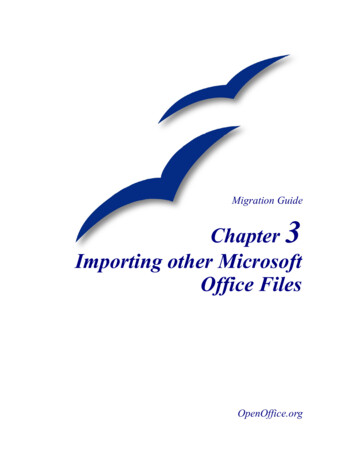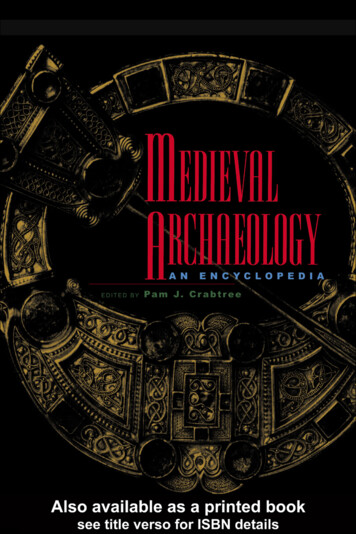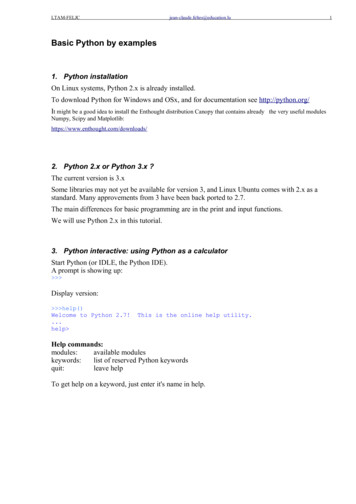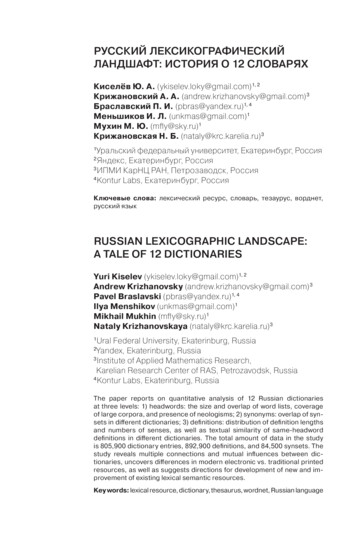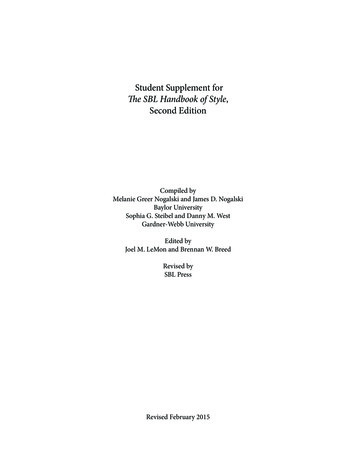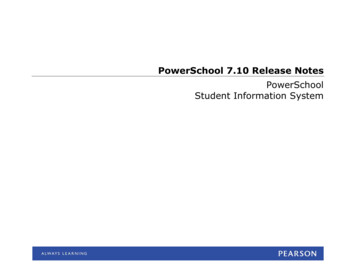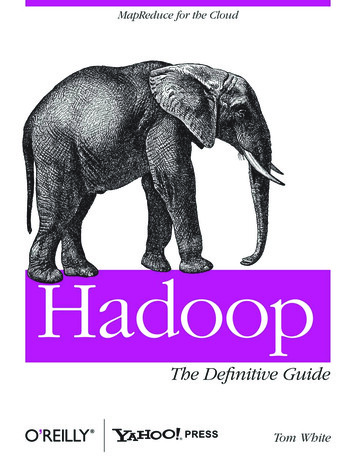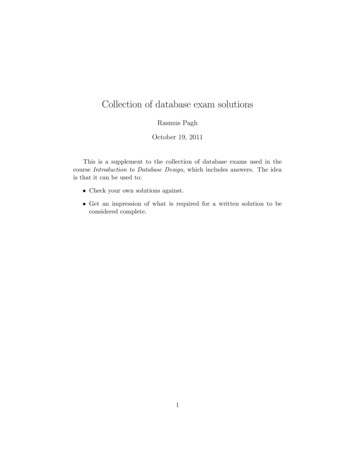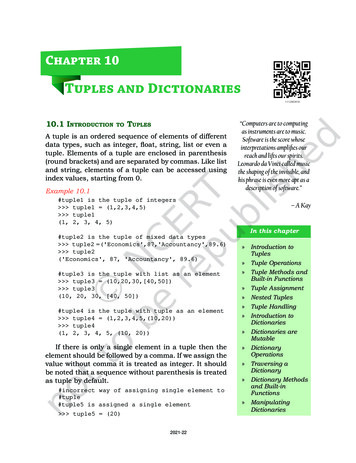
Transcription
Chapter 10Tuples and Dictionaries10.1 IntroductiontoTuplesA tuple is an ordered sequence of elements of differentdata types, such as integer, float, string, list or even atuple. Elements of a tuple are enclosed in parenthesis(round brackets) and are separated by commas. Like listand string, elements of a tuple can be accessed usingindex values, starting from 0.Example 10.1#tuple1 is the tuple of integers tuple1 (1,2,3,4,5) tuple1(1, 2, 3, 4, 5)#tuple2 is the tuple of mixed data types tuple2 ('Economics',87,'Accountancy',89.6) tuple2('Economics', 87, 'Accountancy', 89.6)#tuple3 is the tuple with list as an element tuple3 (10,20,30,[40,50]) tuple3(10, 20, 30, [40, 50])#tuple4 is the tuple with tuple as an element tuple4 (1,2,3,4,5,(10,20)) tuple4(1, 2, 3, 4, 5, (10, 20))If there is only a single element in a tuple then theelement should be followed by a comma. If we assign thevalue without comma it is treated as integer. It shouldbe noted that a sequence without parenthesis is treatedas tuple by default.#incorrect way of assigning single element to#tuple#tuple5 is assigned a single element tuple5 (20)“Computers are to computingas instruments are to music.Software is the score whoseinterpretations amplifies ourreach and lifts our spirits.Leonardo da Vinci called musicthe shaping of the invisible, andhis phrase is even more apt as adescription of software.”– A KayIn this chapter»» Introduction toTuples»» Tuple Operations»» Tuple Methods andBuilt-in Functions»» Tuple Assignment»» Nested Tuples»» Tuple Handling»» Introduction toDictionaries»» Dictionaries areMutable»» DictionaryOperations»» Traversing aDictionary»» Dictionary Methodsand Built-inFunctions»» ManipulatingDictionaries2021-22Ch 10.indd 20708-Apr-19 12:28:09 PM
208Computer Science – ClassWe generally use listto store elements ofthe same data typeswhereas we use tuplesto store elements ofdifferent data types.xi tuple520 type(tuple5) class 'int' #tuple5 is not of type tuple#it is treated as integer#Correct Way of assigning single element to#tuple#tuple5 is assigned a single element tuple5 (20,) #element followed by comma tuple5(20,) type(tuple5)#tuple5 is of type tuple class 'tuple' #a sequence without#tuple by default seq 1,2,3 type(seq) class 'tuple' print(seq)(1, 2, 3)parentheses is treated as#comma separated elements#treated as tuple#seq is a tuple10.1.1 Accessing Elements in a TupleElements of a tuple can be accessed in the same way asa list or string using indexing and slicing. tuple1 (2,4,6,8,10,12)#initializes a tuple tuple1#returns the first element of tuple1 tuple1[0]2#returns fourth element of tuple1 tuple1[3]8#returns error as index is out of range tuple1[15]IndexError: tuple index out of range#an expression resulting in an integer index tuple1[1 4]12#returns first element from right tuple1[-1]1210.1.2 Tuple is ImmutableTuple is an immutable data type. It means that theelements of a tuple cannot be changed after it has beencreated. An attempt to do this would lead to an error. tuple1 (1,2,3,4,5)2021-22Ch 10.indd 20808-Apr-19 12:28:09 PM
Tuples tuple1[4] 10TypeError: 'tuple' object does not supportitem assignmentHowever an element of a tuple may be of mutable type,e.g., a list.#4th element of the tuple2 is a list tuple2 (1,2,3,[8,9])#modify the list element of the tuple tuple2 tuple2[3][1] 10#modification is reflected in tuple2 tuple2(1, 2, 3, [8, 10])10.2 Tuple OperationsandDictionaries209 List is mutable buttuple is immutable.So iterating througha tuple is faster ascompared to a list. If we have data thatdoes not changethen storing thisdata in a tuple willmake sure thatit is not changedaccidentally.10.2.1 ConcatenationPython allows us to join tuples using concatenationoperator depicted by symbol . We can also create a newtuple which contains the result of this concatenationoperation. tuple1 (1,3,5,7,9) tuple2 (2,4,6,8,10) tuple1 tuple2#concatenates two tuples(1, 3, 5, 7, 9, 2, 4, 6, 8, 10) tuple3 ('Red','Green','Blue') tuple4 ('Cyan', 'Magenta', 'Yellow','Black')#tuple5 stores elements of tuple3 and tuple4 tuple5 tuple3 tuple4 ow','Black')Concatenation operator can also be used forextending an existing tuple. When we extend a tupleusing concatenation a new tuple is created. tuple6 (1,2,3,4,5)#single element is appended to tuple6 tuple6 tuple6 (6,) tuple6(1, 2, 3, 4, 5, 6)#more than one elements are appended tuple6 tuple6 (7,8,9) tuple6(1, 2, 3, 4, 5, 6, 7, 8, 9)2021-22Ch 10.indd 20908-Apr-19 12:28:09 PM
210Computer Science – Classxi10.2.2 RepetitionRepetition operation is depicted by the symbol *. It isused to repeat elements of a tuple. We can repeat thetuple elements. The repetition operator requires the firstoperand to be a tuple and the second operand to be aninteger only. tuple1 ('Hello','World') tuple1 * 3('Hello', 'World', 'Hello', 'World', 'Hello','World')#tuple with single element tuple2 ("Hello",) tuple2 * 4('Hello', 'Hello', 'Hello', 'Hello')10.2.3 MembershipThe in operator checks if the element is present in thetuple and returns True, else it returns False. tuple1 ('Red','Green','Blue') 'Green' in tuple1TrueThe not in operator returns True if the element isnot present in the tuple, else it returns False. tuple1 ('Red','Green','Blue') 'Green' not in tuple1False10.2.4 SlicingLike string and list, slicing can be applied to tuples also.#tuple1 is a tuple tuple1 (10,20,30,40,50,60,70,80)#elements from index 2 to index 6 tuple1[2:7](30, 40, 50, 60, 70)#all elements of tuple are printed tuple1[0:len(tuple1)](10, 20, 30, 40, 50, 60, 70, 80)#slice starts from zero index tuple1[:5](10, 20, 30, 40, 50)#slice is till end of the tuple tuple1[2:](30, 40, 50, 60, 70, 80)2021-22Ch 10.indd 21008-Apr-19 12:28:09 PM
TuplesandDictionaries211#step size 2 tuple1[0:len(tuple1):2](10, 30, 50, 70)#negative indexing tuple1[-6:-4](30, 40)#tuple is traversed in reverse order tuple1[::-1](80, 70, 60, 50, 40, 30, 20, 10)10.3 Tuple MethodsandBuilt-in FunctionsPython provides many functions to work on tuples. Table10.1 list some of the commonly used tuple methods andbuilt-in functions.Table 10.1 Built-in functions and methods for tuplesMethodDescriptionExamplelen()Returns the length or the number ofelements of the tuple passed as theargumenttuple()Creates an empty tuple if no argumentis passedCreates a tuple if a sequence ispassed as argument tuple1 (10,20,30,40,50) len(tuple1)5 tuple1 tuple() tuple1( ) tuple1 tuple('aeiou')#string tuple1('a', 'e', 'i', 'o', 'u') tuple2 tuple([1,2,3]) #list tuple2(1, 2, 3) tuple3 tuple(range(5)) tuple3(0, 1, 2, 3, 4)count()Returns the number of times thegiven element appears in the tuple tuple1 (10,20,30,10,40,10,50) tuple1.count(10)3 tuple1.count(90)0index()Returns the index of the firstoccurrence of the element in thegiven tuple tuple1 (10,20,30,40,50) tuple1.index(30)2 tuple1.index(90)ValueError: tuple.index(x): x notin tuple2021-22Ch 10.indd 21108-Apr-19 12:28:09 PM
212sorted()min()Computer Science – ClassxiTakes elements in the tuple andreturns a new sorted list. It shouldbe noted that, sorted() does not makeany change to the original tuple tuple1 ("Rama","Heena","Raj","Mohsin","Aditya")Returns minimumelement of the tuple tuple1 (19,12,56,18,9,87,34)orsmallest sorted(tuple1)['Aditya', 'Heena', 'Mohsin', 'Raj','Rama'] min(tuple1)9max()sum()Returns maximum or largest elementof the tuple max(tuple1)Returns sum of the elements of thetuple sum(tuple1)8723510.4 Tuple AssignmentAssignment of tuple is a useful feature in Python.It allows a tuple of variables on the left side of theassignment operator to be assigned respective valuesfrom a tuple on the right side. The number of variableson the left should be same as the number of elementsin the tuple.Example 10.2#The first element 10 is assigned to num1 and#the second element 20 is assigned to num2. (num1,num2) (10,20) print(num1)10 print(num2)20 record ( "Pooja",40,"CS") (name,rollNo,subject) record name'Pooja' rollNo40 subject'CS' (a,b,c,d) (5,6,8)ValueError: not enough values to unpack(expected 4, got 3)If there is an expression on the right side then firstthat expression is evaluated and finally the result isassigned to the tuple.2021-22Ch 10.indd 21208-Apr-19 12:28:09 PM
TuplesandDictionaries213Example 10.3#15#25 15 25is assigned to num3 andis assigned to num4(num3,num4) (10 5,20 5)print(num3)print(num4)10.5 Nested TuplesA tuple inside another tuple is called a nested tuple.In the program 10-1, roll number, name and marks(in percentage) of students are saved in a tuple. Tostore details of many such students we can create anested tuple.Program 10-1 This is a program to create a nestedtuple to store roll number, name andmarks of students\t is an escapecharacter used foradding horizontaltab space. Anothercommonly usedescape character is\n, used for insertinga new line.#Program 10-1#To store records of students in tuple and print themst (104,"Pawan",79))print("S No"," Roll No","Name"," Marks")for i in range(0,len(st)):print((i t:S No1234Roll 0.6 Tuple HandlingProgram 10-2 Write a program to swap two numberswithout using a temporary variable.#Program 10-2#Program to swap two numbersnum1 int(input('Enter the first number: '))num2 int(input('Enter the second number: '))print("\nNumbers before swapping:")print("First Number:",num1)print("Second Number:",num2)(num1,num2) (num2,num1)print("\nNumbers after swapping:")2021-22Ch 10.indd 21308-Apr-19 12:28:09 PM
214Computer Science – Classxiprint("First Number:",num1)print("Second Number:",num2)Output:Enter the first number: 5Enter the second number: 10Numbers before swapping:First Number: 5Second Number: 10Numbers after swapping:First Number: 10Second Number: 5Program 10-3 Write a program to compute the areaand circumference of a circle using afunction.#Program 10-3#Function to compute area and circumference of the circle.def circle(r):area 3.14*r*rcircumference 2*3.14*r#returns a tuple having two elements area and circumferencereturn (area,circumference)#end of functionradius int(input('Enter radius of circle: '))area,circumference circle(radius)print('Area of circle is:',area)print('Circumference of circle is:',circumference)Output:Enter radius of circle: 5Area of circle is: 78.5Circumference of circle is: 31.400000000000002Program 10-4 Write a program to input n numbersfrom the user. Store these numbers in atuple. Print the maximum and minimumnumber from this tuple.#Program 10-4#Program to input n numbers from the user. Store these numbers#in a tuple. Print the maximum and minimum number from this tuple.numbers tuple()#create an empty tuple 'numbers'n int(input("How many numbers you want to enter?: "))for i in range(0,n):num int(input())#it will assign numbers entered by user to tuple 'numbers'2021-22Ch 10.indd 21408-Apr-19 12:28:09 PM
TuplesandDictionaries215numbers numbers (num,)print('\nThe numbers in the tuple are:')print(numbers)print("\nThe maximum number is:")print(max(numbers))print("The minimum number is:")print(min(numbers))Output:How many numbers do you want to enter?: 598101215The numbers in the tuple are:(9, 8, 10, 12, 15)The maximum number is:15The minimum number is:810.7 IntroductiontoDictionariesThe data type dictionary fall under mapping. It is amapping between a set of keys and a set of values. Thekey-value pair is called an item. A key is separated fromits value by a colon(:) and consecutive items are separatedby commas. Items in dictionaries are unordered, so wemay not get back the data in the same order in whichwe had entered the data initially in the dictionary.10.7.1 Creating a DictionaryTo create a dictionary, the items entered are separated bycommas and enclosed in curly braces. Each item is a keyvalue pair, separated through colon (:). The keys in thedictionary must be unique and should be of any immutabledata type, i.e., number, string or tuple. The values can berepeated and can be of any data type.Example 10.4#dict1 is an empty Dictionary created#curly braces are used for dictionary dict1 {} dict1{}#dict2 is an empty dictionary created using#built-in function2021-22Ch 10.indd 21508-Apr-19 12:28:09 PM
216Computer Science – ClassNotesxi dict2 dict() dict2{}#dict3 is the dictionary that maps names#of the students to respective marks in#percentage dict3 {'Mohan':95,'Ram':89,'Suhel':92,'Sangeeta':85} dict3{'Mohan': 95, 'Ram': 89, 'Suhel': 92,'Sangeeta': 85}10.7.2 Accessing Items in a DictionaryWe have already seen that the items of a sequence(string, list and tuple) are accessed using a techniquecalled indexing. The items of a dictionary are accessedvia the keys rather than via their relative positionsor indices. Each key serves as the index and maps toa value.The following example shows how a dictionaryreturns the value corresponding to the given key: dict3 {'Mohan':95,'Ram':89,'Suhel':92,'Sangeeta':85} dict3['Ram']89 dict3['Sangeeta']85#the key does not exist dict3['Shyam']KeyError: 'Shyam'In the above examples the key 'Ram' always maps tothe value 89 and key 'Sangeeta' always maps to thevalue 85. So the order of items does not matter. If thekey is not present in the dictionary we get KeyError.10.8 DictionariesareMutableDictionaries are mutable which implies that thecontents of the dictionary can be changed after it hasbeen created.10.8.1 Adding a new itemWe can add a new item to the dictionary as shown inthe following example: dict1 -22Ch 10.indd 21608-Apr-19 12:28:10 PM
Tuples dict1['Meena'] 78 dict1{'Mohan': 95, 'Ram': 89, 'Suhel': 92,'Sangeeta': 85, 'Meena': 78}andDictionaries217Notes10.8.2 Modifying an Existing ItemThe existing dictionary can be modified by justoverwriting the key-value pair. Example to modify agiven item in the dictionary: dict1 ks of Suhel changed to 93.5 dict1['Suhel'] 93.5 dict1{'Mohan': 95, 'Ram': 89, 'Suhel': 93.5,'Sangeeta': 85}10.9 Dictionary Operations10.9.1 MembershipThe membership operator in checks if the key is presentin the dictionary and returns True, else it returns False. dict1 {'Mohan':95,'Ram':89,'Suhel':92,'Sangeeta':85} 'Suhel' in dict1TrueThe not in operator returns True if the key is not present inthe dictionary, else it returns False. dict1 {'Mohan':95,'Ram':89,'Suhel':92,'Sangeeta':85} 'Suhel' not in dict1False10.10 TraversingaDictionaryWe can access each item of the dictionary or traverse adictionary using for loop. dict1 od 1 for key in dict1:print(key,':',dict1[key])Mohan: 95Ram: 89Suhel: 92Sangeeta: 852021-22Ch 10.indd 21708-Apr-19 12:28:10 PM
218Computer Science – ClassxiMethod 2 for key,value in dict1.items():print(key,':',value)Mohan: 95Ram: 89Suhel: 92Sangeeta: 8510.11 Dictionarymethods andBuilt-infunctionsPython provides many functions to work on dictionaries. Table 10.2 lists some ofthe commonly used dictionary methods.Methodlen()Table 10.2 Built-in functions and methods for dictionaryDescriptionExampleReturns the length or number ofkey: value pairs of the dictionarypassed as the argument dict1 {'Mohan':95,'Ram':89,'Suhel':92, 'Sangeeta':85} len(dict1)4dict()Creates a dictionary from asequence of key-value pairspair1 85)] pair1[('Mohan', 95), ('Ram', 89), ('Suhel',92), ('Sangeeta', 85)] dict1 dict(pair1) dict1{'Mohan': 95, 'Ram': 89, 'Suhel': 92,'Sangeeta': 85}keys()Returns a listthe dictionaryofkeysin dict1 {'Mohan':95, 'Ram':89,'Suhel':92, 'Sangeeta':85} dict1.keys()dict keys(['Mohan', 'Ram', 'Suhel','Sangeeta'])values()Returns a listthe dictionaryofvaluesin dict1 {'Mohan':95, 'Ram':89,'Suhel':92, 'Sangeeta':85} dict1.values()dict values([95, 89, 92, 85])items()Returns a list of tuples(key –value) pair dict1 {'Mohan':95, 'Ram':89,'Suhel':92, 'Sangeeta':85} dict1.items()dict items([( 'Mohan', 95), ('Ram',89), ('Suhel', 92), ('Sangeeta', 85)])2021-22Ch 10.indd 21808-Apr-19 12:28:10 PM
Tuplesget()Returns the value correspondingto the key passed as theargumentIf the key is not present in thedictionary it will return Noneupdate()appends the key-value pair ofthe dictionary passed as theargument to the key-value pairof the given dictionaryandDictionaries219 dict1 {'Mohan':95, 'Ram':89,'Suhel':92, 'Sangeeta':85} dict1.get('Sangeeta')85 dict1.get('Sohan') dict1 {'Mohan':95, 'Ram':89,'Suhel':92, 'Sangeeta':85} dict2 {'Sohan':79,'Geeta':89} dict1.update(dict2) dict1{'Mohan': 95, 'Ram': 89, 'Suhel': 92,'Sangeeta': 85, 'Sohan': 79, 'Geeta':89} dict2{'Sohan': 79, 'Geeta': 89}del()Deletes the item with the givenkeyTo delete the dictionary from thememory we write:del Dict name dict1 {'Mohan':95,'Ram':89,'Suhel':92, 'Sangeeta':85} del dict1['Ram'] dict1{'Mohan':95,'Suhel':92, 'Sangeeta': 85} del dict1 ['Mohan'] dict1{'Suhel': 92, 'Sangeeta': 85} del dict1 dict1NameError: name 'dict1' is not definedclear()Deletes or clear all the items ofthe dictionary dict1 {'Mohan':95,'Ram':89,'Suhel':92, 'Sangeeta':85} dict1.clear() dict1{ }10.12 Manipulating DictionariesIn this chapter, we have learnt how to create adictionary and apply various methods to manipulate it.The following programs show the application of thosemanipulation methods on dictionaries.2021-22Ch 10.indd 21921-May-19 12:35:47 PM
Computer Science – Class220xiProgram 10-5 Create a dictionary ‘ODD’ of odd numbers between 1 and10, where the key is the decimal number and the value is thecorresponding number in words. Perform the following operationson this dictionary:(a) Display the keys(b) Display the values(c) Display the items(d) Find the length of the dictionary(e) Check if 7 is present or not(f) Check if 2 is present or not(g) Retrieve the value corresponding to the key 9(h) Delete the item from the dictionary corresponding to the key 9 ODD {1:'One',3:'Three',5:'Five',7:'Seven',9:'Nine'} ODD{1: 'One', 3: 'Three', 5: 'Five', 7: 'Seven', 9: 'Nine'}(a) Display the keys ODD.keys()dict keys([1, 3, 5, 7, 9])(b) Display the values ODD.values()dict values(['One', 'Three', 'Five', 'Seven', 'Nine'])(c) Display the items ODD.items()dict items([(1, 'One'), (3, 'Three'), (5, 'Five'), (7, 'Seven'),(9, 'Nine')])(d) Find the length of the dictionary len(ODD)5(e) Check if 7 is present or not 7 in ODDTrue(f) Check if 2 is present or not 2 in ODDFalse(g) Retrieve the value corresponding to the key 9 ODD.get(9)'Nine'2021-22Ch 10.indd 22008-Apr-19 12:28:10 PM
TuplesandDictionaries221(h) Delete the item from the dictionary corresponding to the key 9 del ODD[9] ODD{1: 'One', 3: 'Three', 5: 'Five', 7: 'Seven'}Program 10-6 Write a program to enter names ofemployees and their salaries as inputand store them in a dictionary.#Program 10-6#Program to create a dictionary which stores names of the employee#and their salarynum int(input("Enter the number of employees whose data to bestored: "))count 1employee dict()#create an empty dictionarywhile count num:name input("Enter the name of the Employee: ")salary int(input("Enter the salary: "))employee[name] salarycount 1print("\n\nEMPLOYEE NAME\tSALARY")for k in employee:print(k,'\t\t',employee[k])Output:Enter the number of employees to be stored: 5Enter the name of the Employee: 'Tarun'Enter the salary: 12000Enter the name of the Employee: 'Amina'Enter the salary: 34000Enter the name of the Employee: 'Joseph'Enter the salary: 24000Enter the name of the Employee: 'Rahul'Enter the salary: 30000Enter the name of the Employee: 'Zoya'Enter the salary: 25000EMPLOYEE hul'30000'Zoya'25000Program 10-7 Write a program to count the numberof times a character appears in a givenstring.#Program 10-7#Count the number of times a character appears in a given string2021-22Ch 10.indd 22108-Apr-19 12:28:10 PM
Computer Science – Class222xist input("Enter a string: ")dic {}#creates an empty dictionaryfor ch in st:if ch in dic:#if next character is already in the dictionarydic[ch] 1else:dic[ch] 1 #if ch appears for the first timefor key in dic:print(key,':',dic[key])Output:Enter a string: HelloWorldH : 1e : 1l : 3o : 2W : 1r : 1d : 1Program 10-8 Write a function to convert a numberentered by the user into its correspondingnumber in words. For example, if theinput is 876 then the output should be‘Eight Seven Six’.# Program 10-8# Write a function to convert number into corresponding number in# wordsdef convert(num):#numberNames is a dictionary of digits and corresponding number#namesnumberNames ive',6:'Six',7:'Seven',8:'Eight',9:'Nine'}result ''for ch in num:key int(ch)#converts character to integervalue numberNames[key]result result ' ' valuereturn resultnum input("Enter any number: ")result convert(num)print("The number is:",num)print("The numberName is:",result)#number is stored as stringOutput:Enter any number: 6512The number is: 6512The numberName is: Six Five One Two2021-22Ch 10.indd 22208-Apr-19 12:28:10 PM
TuplesandDictionaries223NotesSummary Tuples are immutable sequences, i.e., we cannotchange the elements of a tuple once it is created. Elements of a tuple are put in round bracketsseparated by commas. If a sequence has comma separated elementswithout parentheses, it is also treated as a tuple. Tuples are ordered sequences as each elementhas a fixed position. Indexing is used to access the elements of thetuple; two way indexing holds in dictionaries asin strings and lists. Operator ‘ ’ adds one sequence (string, list, tuple)to the end of other. Operator ‘*’ repeats a sequence (string, list, tuple)by specified number of times Membership operator ‘in’ tells if an element ispresent in the sequence or not and ‘not in’ doesthe opposite. Tuple manipulation functions are: len(), tuple(),count(), index(), sorted(), min(), max(),sum(). Dictionary is a mapping (non-scalar) data type. Itis an unordered collection of key-value pair; keyvalue pair are put inside curly braces. Each key is separated from its value by a colon. Keys are unique and act as the index. Keys are of immutable type but values canbe mutable.Exercise1. Consider the following tuples, tuple1 and tuple2:tuple1 (23,1,45,67,45,9,55,45)tuple2 (100,200)Find the output of the following print(tuple1.count(45))print(tuple1 in(tuple1))2021-22Ch 10.indd 22308-Apr-19 12:28:10 PM
224Computer Science – ClassNotesxivii. print(sum(tuple2))viii. p r i n t ( s o r t e d ( t u p l e 1 ) )print(tuple1)2. Consider the following dictionary stateCapital:stateCapital rashtra":"Mumbai","Rajasthan":"Jaipur"}Find the output of the following rint(len(stateCapital))print("Maharashtra" in stateCapital)print(stateCapital.get("Assam"))del stateCapital["Rajasthan"]print(stateCapital)3. “Lists and Tuples are ordered”. Explain.4. With the help of an example show how can youreturn more than one value from a function.5. What advantages do tuples have over lists?6. When to use tuple or dictionary in Python. Give someexamples of programming situations mentioningtheir usefulness.7. Prove with the help of an example that the variableis rebuilt in case of immutable data types.8. TypeError occurs while statement 2 is running.Give reason. How can it be corrected? tuple1 (5) len(tuple1)#statement 1#statement 2Programming Problems1. Write a program to read email IDs of n number ofstudents and store them in a tuple. Create two newtuples, one to store only the usernames from theemail IDs and second to store domain names fromthe email IDs. Print all three tuples at the end of theprogram. [Hint: You may use the function split()]2. Write a program to input names of n students andstore them in a tuple. Also, input a name from theuser and find if this student is present in the tuple or not.Ch 10.indd 22415-Jun-21 11:19:20 AM
TuplesandDictionaries225NotesWe can accomplish these by:(a) writing a user defined function(b) using the built-in function3. Write a Python program to find the highest 2 valuesin a dictionary.4. Write a Python program to create a dictionary froma string.Note: Track the count of the letters from the string.Sample string: 'w3resource'Expected output : {'3': 1, 's': 1, 'r': 2, 'u': 1, 'w': 1, 'c': 1,'e': 2, 'o': 1}5. Write a program to input your friends’ namesand their Phone Numbers and store them in thedictionary as the key-value pair. Perform thefollowing operations on the dictionary:a) Display the name and phone number of all yourfriendsb) Add a new key-value pair in this dictionary anddisplay the modified dictionaryc) Delete a particular friend from the dictionaryd) Modify the phone number of an existing friende) Check if a friend is present in the dictionary ornotf) Display the dictionary in sorted order of namesCase Study-based QuestionFor the SMIS System given in Chapter 5, let us dothe following:Write a program to take in the roll number, name andpercentage of marks for n students of Class X. Writeuser defined functions to accept details of the n students (n is the numberof students) search details of a particular student on thebasis of roll number and display result display the result of all the students find the topper amongst them find the subject toppers amongst them(Hint: use Dictionary, where the key can be roll numberand the value is an immutable data type containingname and percentage)2021-22Ch 10.indd 22521-May-19 12:39:48 PM
226Computer Science – ClassNotesxiLet’s peer review the case studies of others based onthe parameters given under “DOCUMENTATION TIPS”at the end of Chapter 5 and provide a feedback to them.Case Study-based Questions1. A bank is a financial institution which is involved inborrowing and lending of money. With advancementin technology, online banking, also known asinternet banking allows customers of a bank toconduct a range of financial transactions throughthe bank’s website anytime, anywhere. As part ofinitial investigation you are suggested to collect a bank’s application form. After carefulanalysis of the form, identify the informationrequired for opening a savings account. Alsoenquire about the rate of interest offered for asaving account. The basic two operations performed on anaccount are Deposit and Withdrawal. Write amenu driven program that accepts either of thetwo choices of Deposit and Withdrawal, thenaccepts an amount, performs the er, every bank has a requirement ofminimum balance which needs to be taken careof during withdrawal operations. Enquire aboutthe minimum balance required in your bank. Collect the interest rates for opening a fixeddeposit in various slabs in a savings bankaccount. Remember, rates may be different forsenior citizens.Finally, write a menu driven program having thefollowing options (use functions and appropriatedata types): Open a savings bank account Deposit money Withdraw money Take details, such as amount and period for aFixed Deposit and display its maturity amountfor a particular customer.2. Participating in a quiz can be fun as it provides acompetitive element. Some educational institutesuse it as a tool to measure knowledge level, abilities2021-22Ch 10.indd 22608-Apr-19 12:28:10 PM
Tuplesand/or skills of their pupils either on a general levelor in a specific field of study. Identify and analysepopular quiz shows and write a Python program tocreate a quiz that should also contain the followingfunctionalities besides the one identified by you asa result of your analysis. Create an administrative user ID and passwordto categorically add, modify, delete a question Register the student before allowing her or himto play a quiz Allow selection of category based on subject area Display questions as per the chosen category Keep the score as the participant plays Display the final scoreandDictionaries227Notes3. Our heritage monuments are our assets. They area reflection of our rich and glorious past and aninspiration for our future. UNESCO has identifiedsome of Indian heritage sites as World heritagesites. Collect the following information about thesesites: What is the name of the site? Where is it located? District State When was it built? Who built it? Why was it built? Website link (if any).Write a Python program to create an administrative user ID and passwordto add, modify or delete an entered heritage sitein the list of sites display the list of world heritage sites in India search and display information of a worldheritage site entered by the user display the name(s) of world heritage site(s) onthe basis of the state input by the user.4. Every mode of transport utilises a reservationsystem to ensure its smooth and efficientfunctioning. If you analyse you would find manythings in common. You are required to identify2021-22Ch 10.indd 22708-Apr-19 12:28:10 PM
228Computer Science – Classxiany one mode of transportation and prepare areservation system for it. For example, let us lookat
212 COMPTER SCIENCE – CLASS XI sorted() Takes elements in the tuple and returns a new sorted list. It should be noted that
